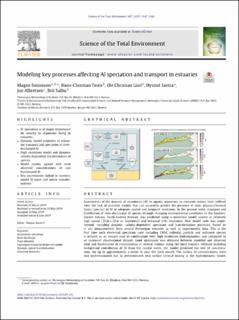| dc.contributor.author | Simonsen, Magne | |
| dc.contributor.author | Teien, Hans-Christian | |
| dc.contributor.author | Lind, Ole Christian | |
| dc.contributor.author | Sætra, Øyvind | |
| dc.contributor.author | Albretsen, Jon | |
| dc.contributor.author | Salbu, Brit | |
| dc.date.accessioned | 2020-07-09T10:49:37Z | |
| dc.date.available | 2020-07-09T10:49:37Z | |
| dc.date.created | 2019-07-02T11:56:59Z | |
| dc.date.issued | 2019 | |
| dc.identifier.citation | Science of the Total Environment. 2019, 687, 1147-1163. | en_US |
| dc.identifier.issn | 0048-9697 | |
| dc.identifier.uri | https://hdl.handle.net/11250/2661607 | |
| dc.description.abstract | Assessments of the impacts of aluminium (Al) to aquatic organisms in estuarine waters have suffered from the lack of available models that can accurately predict the presence of toxic physico-chemical forms (species) of Al at adequate spatial and temporal resolution. In the present work, transport and distribution of river-discharged Al species through changing environmental conditions in the Sandnesfjorden estuary, South-Eastern Norway, was predicted using a numerical model system at relatively high spatial (32 m × 32 m in horizontal) and temporal (1 h) resolution. New model code was implemented, including dynamic, salinity-dependent speciation and transformation processes, based on in situ measurements from several Norwegian estuaries as well as experimental data. This is the first time such elemental speciation code including LMM, colloidal, particle and sediment species is utilized in an estuary case in combination with high resolution hydrodynamics and compared to an extensive observational dataset. Good agreement was obtained between modeled and observed total and fractionated Al concentration at several stations along the fjord transect. Without including background contribution of Al from the coastal water, the model predicted too low Al concentrations (by up to approximately a factor 4) near the fjord mouth. The surface Al concentrations were also underestimated due to overestimated near-surface vertical mixing in the hydrodynamic model. The observed correlation between salinity and total Al concentration was well reproduced by the model in situations with low upper layer volume flux, typical under low river flow conditions. In contrast, the predicted surface salinity and total Al concentration were less correlated under high-flux conditions. As the general trends of Al concentrations and speciation were well reproduced, this study demonstrated that by including carefully chosen transfer rates, the model can be used to predict spatio-temporal distribution of total contamination as well as concentration levels of the elemental species. | en_US |
| dc.language.iso | eng | en_US |
| dc.rights | Attribution-NonCommercial-NoDerivatives 4.0 Internasjonal | * |
| dc.rights.uri | http://creativecommons.org/licenses/by-nc-nd/4.0/deed.no | * |
| dc.title | Modeling key processes affecting Al speciation and transport in estuaries | en_US |
| dc.type | Peer reviewed | en_US |
| dc.type | Journal article | en_US |
| dc.description.version | publishedVersion | en_US |
| dc.source.pagenumber | 1147-1163 | en_US |
| dc.source.volume | 687 | en_US |
| dc.source.journal | Science of the Total Environment | en_US |
| dc.identifier.doi | 10.1016/j.scitotenv.2019.05.318 | |
| dc.identifier.cristin | 1709304 | |
| dc.relation.project | Notur/NorStore: NN9482K | en_US |
| dc.relation.project | Norges forskningsråd: 223268 (CERAD) | en_US |
| cristin.unitcode | 192,14,0,0 | |
| cristin.unitname | Miljøvitenskap og naturforvaltning | |
| cristin.ispublished | true | |
| cristin.fulltext | original | |
| cristin.qualitycode | 2 | |

